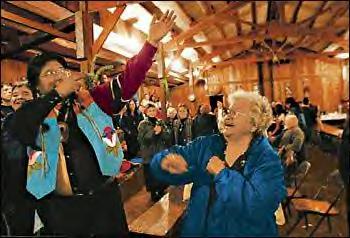 A
blue haze engulfs the tiny kitchen as Nikki Burfiend fries fresh oysters
and geoduck fritters in a skillet popping with fat. Outside, steam from
fuming cauldrons full of clams and oysters twines with sweet alder smoke
from sockeye filets sizzling on a homemade grill. A
blue haze engulfs the tiny kitchen as Nikki Burfiend fries fresh oysters
and geoduck fritters in a skillet popping with fat. Outside, steam from
fuming cauldrons full of clams and oysters twines with sweet alder smoke
from sockeye filets sizzling on a homemade grill.
Elk roasts pack two ovens to their doors;
elk steaks and elk ribs stuff two counter-top cookers.
All around the Skokomish Indian
Reservation here on the elbow of Hood Canal's long arm — at home,
at the tribal-center kitchen and especially in the packed little kitchen
across from the longhouse — a feast is in the making.
This dinner is in celebration of
the state Board of Education's move to allow Indians to decide who shall
teach their tribal language and culture in public schools. Tribal members
from across Washington who worked years for this change will soon arrive
to feast.
For in Indian country, if it matters
— happy or sad — it's marked with a dinner prepared by tribal
cooks working from recipes in their heads, able to measure ingredients
between the lines of their palms.
Head cook for this dinner is Burfiend,
who spends most days managing the Twin Totems convenience store on the
reservation.
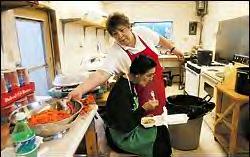 Burfiend
arrives at the longhouse before 9 this morning, already wearing her apron
as she drives up in her white Ford Taurus — the trunk packed with
freshly butchered elk and live geoduck straining at rubber bands that
keep them shut. Focused, 55 and more than 6 feet tall, she's strong enough
to lug a case of the raw elk up the kitchen steps without breaking stride. Burfiend
arrives at the longhouse before 9 this morning, already wearing her apron
as she drives up in her white Ford Taurus — the trunk packed with
freshly butchered elk and live geoduck straining at rubber bands that
keep them shut. Focused, 55 and more than 6 feet tall, she's strong enough
to lug a case of the raw elk up the kitchen steps without breaking stride.
Her partner in marshaling tonight's
dinner is Harriet Gouley, 67, a registered nurse who will cook and clean
crab and make salads for 200 in between filling in at the clinic to give
allergy shots.
In all, nearly a dozen tribal members
will help cook this feast. It will be a crab-gutting, rib-whacking, gravy-making,
fritter-frying marathon for people who have been crack cooks since they
were kids.
"It's something you just grow
up with, something we do hand to heart," says Anne Pavel, 72, as
she peels pound after pound of potatoes. "It didn't seem like there
was any beginning; you just grow up with it. I started when I was little,
setting up the table and putting out the spoons and the forks, when I
was 5 or 6 years old."
Though not in the kitchen tonight,
Rena Pulsifer, 59, has been cooking since she was a kid, too. "By
the time I was 12 or 13 I could cook a full-course meal — and that
was on a woodstove."
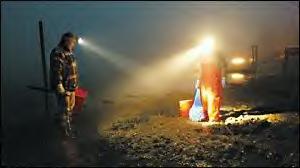 A
Chehalis Indian living at Skokomish, Pulsifer has cooked many a feast
for the Shaker Church on the reservation, keeping a candle lit as she
works. "It's God's light, to bless the work and the food as it is
being prepared." A
Chehalis Indian living at Skokomish, Pulsifer has cooked many a feast
for the Shaker Church on the reservation, keeping a candle lit as she
works. "It's God's light, to bless the work and the food as it is
being prepared."
While from different religions
and families, traditions and tribes, the cooks on the reservation have
this in common: Whether they cook for a traditional longhouse ceremony,
the Shaker Church or a community dinner, their service is a high honor.
At this dinner, as is customary, the cooks will be the first to be thanked.
And no cook works alone: "We
all have our own little crew," Pulsifer says. "People you know
can work as hard as you."
Asked by the tribe or a family
to cook for a feast, a cook will hardly ever refuse. "It's a way
of giving," says Pulsifer. "It's not something you learn in
a book.
"We were taught, when cooking,
to go in there with happy thoughts because it will go into the food, and
the food is medicine for those who eat it.
"I see this at every reservation
I go to: The dinners are when everyone comes together. Whatever family
feud that might be going on, it's put away for that day. Our community
dinners are when they put away their hurt feelings, their bitterness.
I keep telling myself one of these days we'll forget to pick them back
up."
MUSCLING A POT of homemade geoduck
chowder from her grandmother's recipe into the crowded kitchen, LaMetta
LaClair, 52, says each cook, no matter how he or she fits into this dinner,
plays an important spiritual role. "You have to think of all the
kitchens that are part of this celebration and know that whoever is cooking,
in the big picture, our hearts have to be one. That is how we are trained.
"What could be better, to
grind the clams, cook the bacon, peel the onions while tears come down
your eyes, when we are doing it, it's not for us. We don't know whose
spirit has been so hungry for clam chowder, for geoduck chowder, how good
it makes them feel. There are no words for that, and when there are, it's
to thank the Creator. He didn't give us this rich culture not to share
it.
"I think about how wealthy
we are, not in money, but in the love that we have in people. We have
a lot of obstacles, but the greatest gift we have is one another."
Outside, Gordon Nielsen, tending
the grill, samples a chunk of salmon. "This," he says, lifting
the scarlet meat to his mouth, "is our wealth.
"The way we believe is that
when you cook for the people, how you cook, that makes a difference in
how the people live. You are not just filling the bellies, but filling
the spirit. You feed their spirit, you feed their hearts. That's what
the joy of cooking is to me, is to be able to care for the people."
While the cooks' work has a spiritual
purpose, it's no romantic idyll. Blood and sweat are definitely required.
So is knowing how to make do with the tools at hand. A hatchet, it turns
out, is just right for hacking apart elk ribs before braising. A fuel-oil
tank cut in half makes a great barbecue grill. Leaving the kitchen door
open makes a fine exhaust fan. A cinderblock is a great hot plate —
it neither burns the hand nor sticks to the dish. And cooking more than
200 pounds of Dungeness crab is best done in big kettles, fired by propane,
outside on the grass.
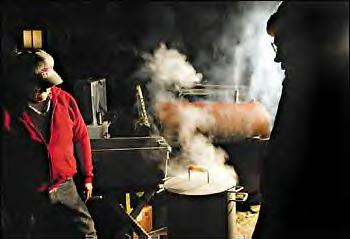 It's
hard work, and not just for the cooks. Preparation for this winter feast
began at least a week in advance. Tribal members caught crabs in Hood
Canal, gathered clams and oysters, shot and butchered a 350-pound elk. It's
hard work, and not just for the cooks. Preparation for this winter feast
began at least a week in advance. Tribal members caught crabs in Hood
Canal, gathered clams and oysters, shot and butchered a 350-pound elk.
As the dinner hour nears, the live
crabs are rousted from tanks in a fisherman's garage and hauled to the
longhouse, pointy claws poking through the drainage holes of their container.
Destiny awaits them in the person of Gouley, standing at the boiling pot.
Gouley, her brother, Tom, and his
daughter, Margie, lift, boil, rinse and clean the crabs, icing them down
in coolers as they go. After that, there are 50 dozen oysters and 80 pounds
of clams to clean and steam.
By 6 p.m., it's crunch time with
guests arriving in an hour. This is where community cooks show their stuff:
knowing exactly how long it takes to boil 50 pounds of potatoes; roast
40 pounds of meat; barbecue 10 or 15 salmon, and make sure everything
is done almost at the same time.
"This is the serious stuff,"
says Burfiend. Even with the pressure on, she remains unflappable. "I've
been cooking with my grandma since I was a teenager. There's nothing to
worry about. It all comes together. If you are upset, if you have any
anxiety, you get it done before the food. You come in with a good heart,
so the food comes out good."
Burfiend whips the lids off pots,
checks her stew, her elk steaks and ribs and roasts, starts thickening
the gravy and breading and frying more than two gallons of fresh oysters.
Margie Gouley starts frying geoduck
fritters alongside Burfiend as more cooks begin arriving with special
dishes, from homemade bread to elk meatballs.
Burfiend whacks with a chef's knife
at 25 smoked-sockeye-salmon filets — a last-minute surprise gift
from the Nooksack tribe.
Her thumb cramps just as tribal
elder Sarah Peterson from the Similkameen tribe in Canada, snowy-haired
and serene, arrives bearing a sack of roots and berries.
She wants a big pot and a burner.
She's an elder, she's a guest,
it's a gift of Indian food, and her pot is soon bubbling with serviceberry
and bitterroot, sugar and flour.
It's not yet dinnertime and already,
the guests are starting to arrive: From Makah and Colville, Yakama, and
Lower Elwha. Jamestown, Kalispel, Chehalis, Squaxin Island, Lummi and
Tulalip, Muckleshoot, Puyallup, Quileute, Quinault and Spokane. Nineteen
tribes will feast tonight.
ANY NIGHT OF the year, on any reservation
in Washington, a ceremonial or community dinner may be under way. Any
reason will do to "spread the table," as giving a dinner is
called, from coming into a little money to getting over an illness; announcing
an engagement or mourning a death.
Like a force of nature, profound, complex, entirely self-contained and
timeless, this tradition survived the spiritual clear-cutting of U.S.
government policy for more than 100 years. Even as the federal government
outlawed tribal languages, religion and potlatches, the dinners continued,
under the guise of wedding feasts, funeral ceremonies and such.
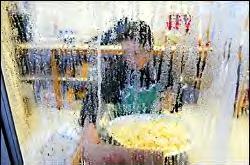 "They
didn't disallow our observance of food or the ritual of food, because
that wasn't considered dangerous," says Bruce Miller, a Skokomish
spiritual and cultural leader. "They didn't consider our eating styles
to be part of our religion, to be part of our philosophy, to be part of
our self-identity." "They
didn't disallow our observance of food or the ritual of food, because
that wasn't considered dangerous," says Bruce Miller, a Skokomish
spiritual and cultural leader. "They didn't consider our eating styles
to be part of our religion, to be part of our philosophy, to be part of
our self-identity."
An estimated 8,000 people feasted
at the longhouse alone last year, Miller says.
Some Skokomish tribal members also
gather every fall to recognize the importance of their aboriginal foods
and pray for them. "We bless all the foods that the Great Spirit
has given to us, and that doesn't include the foods that we can buy at
the supermarket," Miller says.
They give thanks first for water.
"We acknowledge that water is the root of all life," he explains.
Next come the salmon: "To us the salmon is a holy food, it's considered
one of the first foods given to our aboriginal people here in Puget Sound."
Then, the game: deer, elk and the
mountain goat, "all the grass-eating, hooved ones." After that,
the shellfish: crabs, shrimp, clams and oysters. Next the waterfowl, ducks
and geese; then the roots — camas most of all — and finally
the berries, "of which the huckleberry is the lord of all berries."
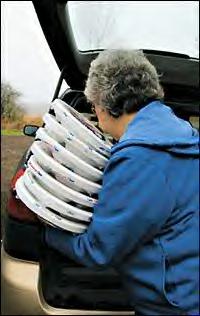 A
traditional dinner may be planned as much as a year in advance, so the
host will have time to gather each food in its season. How the food is
prepared and served is as important as the food itself. The food is set
out in the order of its blessing. Orderliness is important to signal a
sense of calm and harmony — within each cook and among them. So is
serving the food with a generous spirit, Miller says. A
traditional dinner may be planned as much as a year in advance, so the
host will have time to gather each food in its season. How the food is
prepared and served is as important as the food itself. The food is set
out in the order of its blessing. Orderliness is important to signal a
sense of calm and harmony — within each cook and among them. So is
serving the food with a generous spirit, Miller says.
"It is an integral part of
the hospitality of the aboriginal people of this land. As I think back
to the time of the Pilgrims, the first things the colonialists were offered
by the Indians was food. It says we will share survival with you. Food
represented the open arm of friendship.
"Our Puget Salish aboriginal
indigenous food remains sacred to us."
BUILT BY MILLER'S family and named
for his mother, the House of Sle'nay is the setting for tonight's dinner.
A simple A-frame with weathered cedar siding and a metal roof, the longhouse
is a spiritual home for traditional gatherings. Inside, tiered cedar risers
line the two long walls; a woodstove blazes at either end.
It smells good in here, of cedar,
wood smoke and the earthen floor. Mixed with sand from the beach, the
earth floor is raked smooth daily, so it is fresh and unmarked before
each use.
Bunches of dried roots hang atop
each entry to purify the feelings of those who pass through. Cedar branches
in the four corners represent eternal life of the soul, and the teachings
of the cedar: generosity, hospitality, flexibility and patience.
 The
skulls of elks hang from the rafters, honoring the game animals. Eagle
feathers hang from the antlers, honoring the birds. Paintings along two
walls signify the teachings of the wolf: the importance of order; of hierarchy;
of unity; and that only the strong survive. The
skulls of elks hang from the rafters, honoring the game animals. Eagle
feathers hang from the antlers, honoring the birds. Paintings along two
walls signify the teachings of the wolf: the importance of order; of hierarchy;
of unity; and that only the strong survive.
"We are still here,"
says guest Theron Parker, the Makah tribal member who in 1999 harpooned
his tribe's first gray whale in 70 years. "Our way is not in the
past. It's never really been dead. It's just tucked away.
"We are still here and getting
stronger every day."
As night falls, the guests begin
to arrive to the welcoming fires of the longhouse, amid drumming and singing
by their Skokomish hosts. No mealy Muzak here.
Everyone eyes the spread of food
on their way in.
It takes tables laid end to end
to hold it all: Elk meatballs. Slices of roast elk. Baked beans. Elk stew
with gravy. Pan-sautéed elk steaks. Braised elk ribs. Boiled red
potatoes. Potato salad. Green salad with tiny shrimp. Geoduck chowder.
Geoduck fritters. Fried oysters. Clam chowder. Barbecued salmon. Smoked
salmon. Dungeness crab. Steamed clams and oysters. Fry bread. Flat bread.
And atop each woodstove, a pot of wild cranberry-leaf tea — swamp
tea, to those who know it.
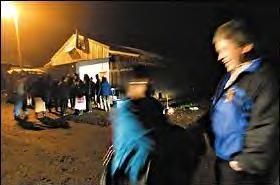 Across
the room is the dessert table: Peterson's late-arriving roots and berries
cooked to a sweet and tangy sauce, and cakes, one frosted with Cool Whip
and pineapple. Across
the room is the dessert table: Peterson's late-arriving roots and berries
cooked to a sweet and tangy sauce, and cakes, one frosted with Cool Whip
and pineapple.
Elders and honored guests are served
first at tables in the center of the room. Teens ferry the plates of food
dished up and passed to them by Burfiend and Gouley. More guests wait
on the packed cedar risers, eager to line up at those loaded tables. They
serve themselves until their paper plates buckle.
It's the moment these cooks have
worked for, all of them, as their guests bend to the feast. Their plates
are full, the fires blazing, the singers belting it out, the doors and
windows thrown open to the night sky.
After everyone is served, after
bulging Ziploc bags of extra crab, clams and oysters are distributed to
the elders (good cooks always make more than enough), after 12 hours on
their feet, Gouley and Burfiend finally sit down.
And eat.
RECIPES
Fried
oysters, barbequed salmon and more
|


![]()
 A
blue haze engulfs the tiny kitchen as Nikki Burfiend fries fresh oysters
and geoduck fritters in a skillet popping with fat. Outside, steam from
fuming cauldrons full of clams and oysters twines with sweet alder smoke
from sockeye filets sizzling on a homemade grill.
A
blue haze engulfs the tiny kitchen as Nikki Burfiend fries fresh oysters
and geoduck fritters in a skillet popping with fat. Outside, steam from
fuming cauldrons full of clams and oysters twines with sweet alder smoke
from sockeye filets sizzling on a homemade grill.  Burfiend
arrives at the longhouse before 9 this morning, already wearing her apron
as she drives up in her white Ford Taurus — the trunk packed with
freshly butchered elk and live geoduck straining at rubber bands that
keep them shut. Focused, 55 and more than 6 feet tall, she's strong enough
to lug a case of the raw elk up the kitchen steps without breaking stride.
Burfiend
arrives at the longhouse before 9 this morning, already wearing her apron
as she drives up in her white Ford Taurus — the trunk packed with
freshly butchered elk and live geoduck straining at rubber bands that
keep them shut. Focused, 55 and more than 6 feet tall, she's strong enough
to lug a case of the raw elk up the kitchen steps without breaking stride.
 A
Chehalis Indian living at Skokomish, Pulsifer has cooked many a feast
for the Shaker Church on the reservation, keeping a candle lit as she
works. "It's God's light, to bless the work and the food as it is
being prepared."
A
Chehalis Indian living at Skokomish, Pulsifer has cooked many a feast
for the Shaker Church on the reservation, keeping a candle lit as she
works. "It's God's light, to bless the work and the food as it is
being prepared." 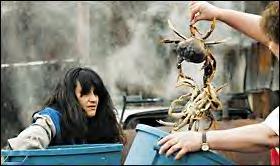

 It's
hard work, and not just for the cooks. Preparation for this winter feast
began at least a week in advance. Tribal members caught crabs in Hood
Canal, gathered clams and oysters, shot and butchered a 350-pound elk.
It's
hard work, and not just for the cooks. Preparation for this winter feast
began at least a week in advance. Tribal members caught crabs in Hood
Canal, gathered clams and oysters, shot and butchered a 350-pound elk.



 "They
didn't disallow our observance of food or the ritual of food, because
that wasn't considered dangerous," says Bruce Miller, a Skokomish
spiritual and cultural leader. "They didn't consider our eating styles
to be part of our religion, to be part of our philosophy, to be part of
our self-identity."
"They
didn't disallow our observance of food or the ritual of food, because
that wasn't considered dangerous," says Bruce Miller, a Skokomish
spiritual and cultural leader. "They didn't consider our eating styles
to be part of our religion, to be part of our philosophy, to be part of
our self-identity."  A
traditional dinner may be planned as much as a year in advance, so the
host will have time to gather each food in its season. How the food is
prepared and served is as important as the food itself. The food is set
out in the order of its blessing. Orderliness is important to signal a
sense of calm and harmony — within each cook and among them. So is
serving the food with a generous spirit, Miller says.
A
traditional dinner may be planned as much as a year in advance, so the
host will have time to gather each food in its season. How the food is
prepared and served is as important as the food itself. The food is set
out in the order of its blessing. Orderliness is important to signal a
sense of calm and harmony — within each cook and among them. So is
serving the food with a generous spirit, Miller says.  The
skulls of elks hang from the rafters, honoring the game animals. Eagle
feathers hang from the antlers, honoring the birds. Paintings along two
walls signify the teachings of the wolf: the importance of order; of hierarchy;
of unity; and that only the strong survive.
The
skulls of elks hang from the rafters, honoring the game animals. Eagle
feathers hang from the antlers, honoring the birds. Paintings along two
walls signify the teachings of the wolf: the importance of order; of hierarchy;
of unity; and that only the strong survive.  Across
the room is the dessert table: Peterson's late-arriving roots and berries
cooked to a sweet and tangy sauce, and cakes, one frosted with Cool Whip
and pineapple.
Across
the room is the dessert table: Peterson's late-arriving roots and berries
cooked to a sweet and tangy sauce, and cakes, one frosted with Cool Whip
and pineapple.